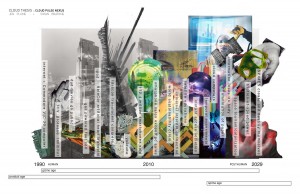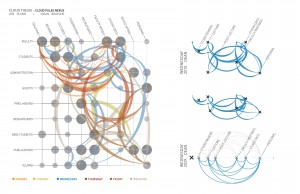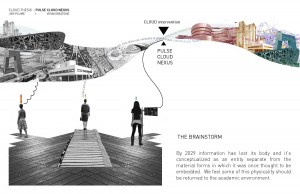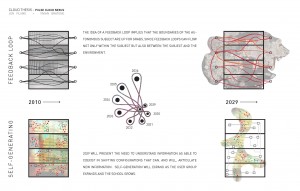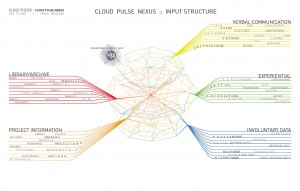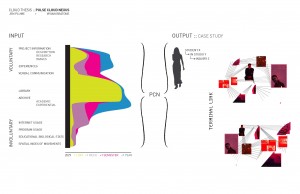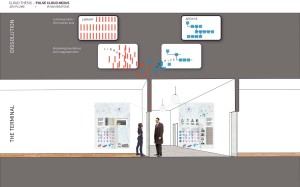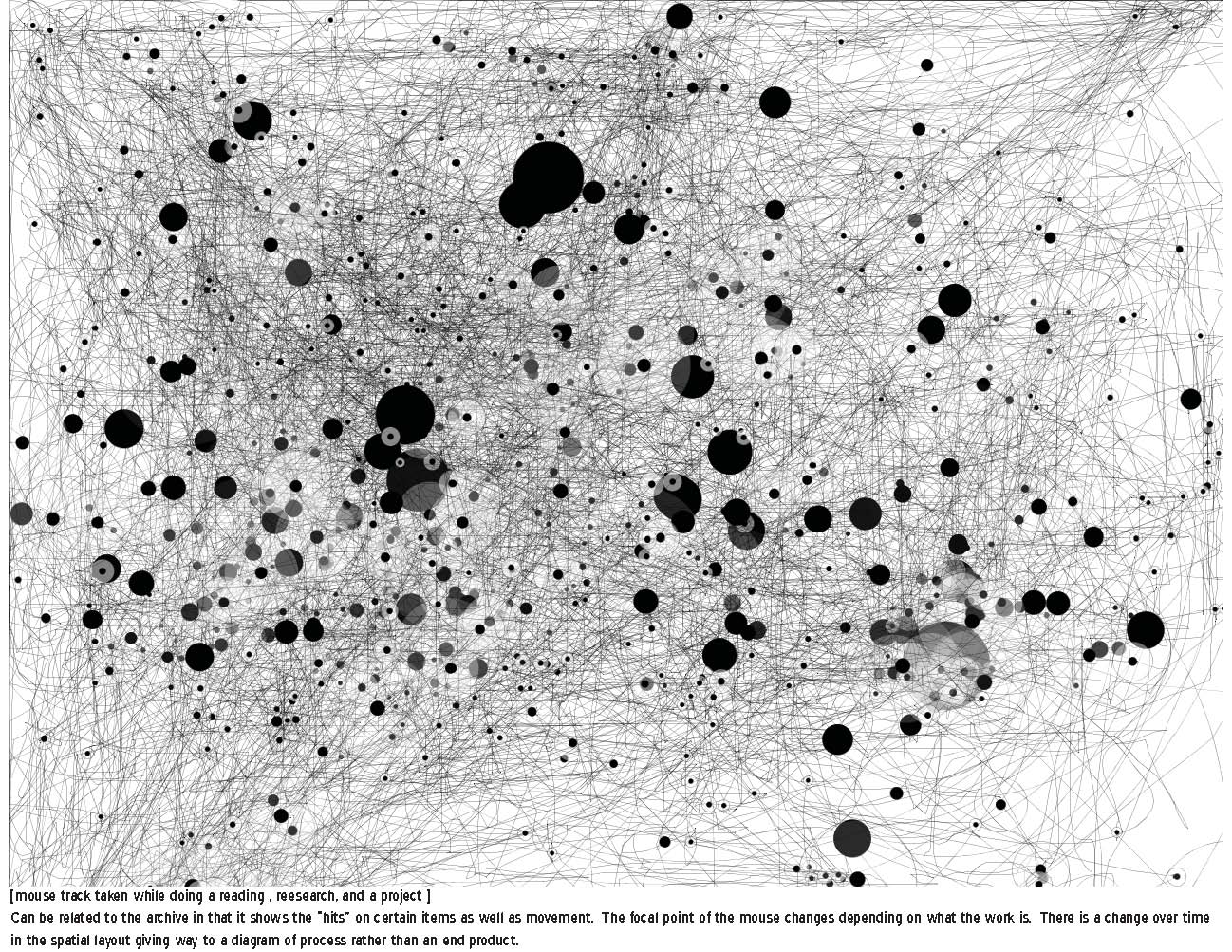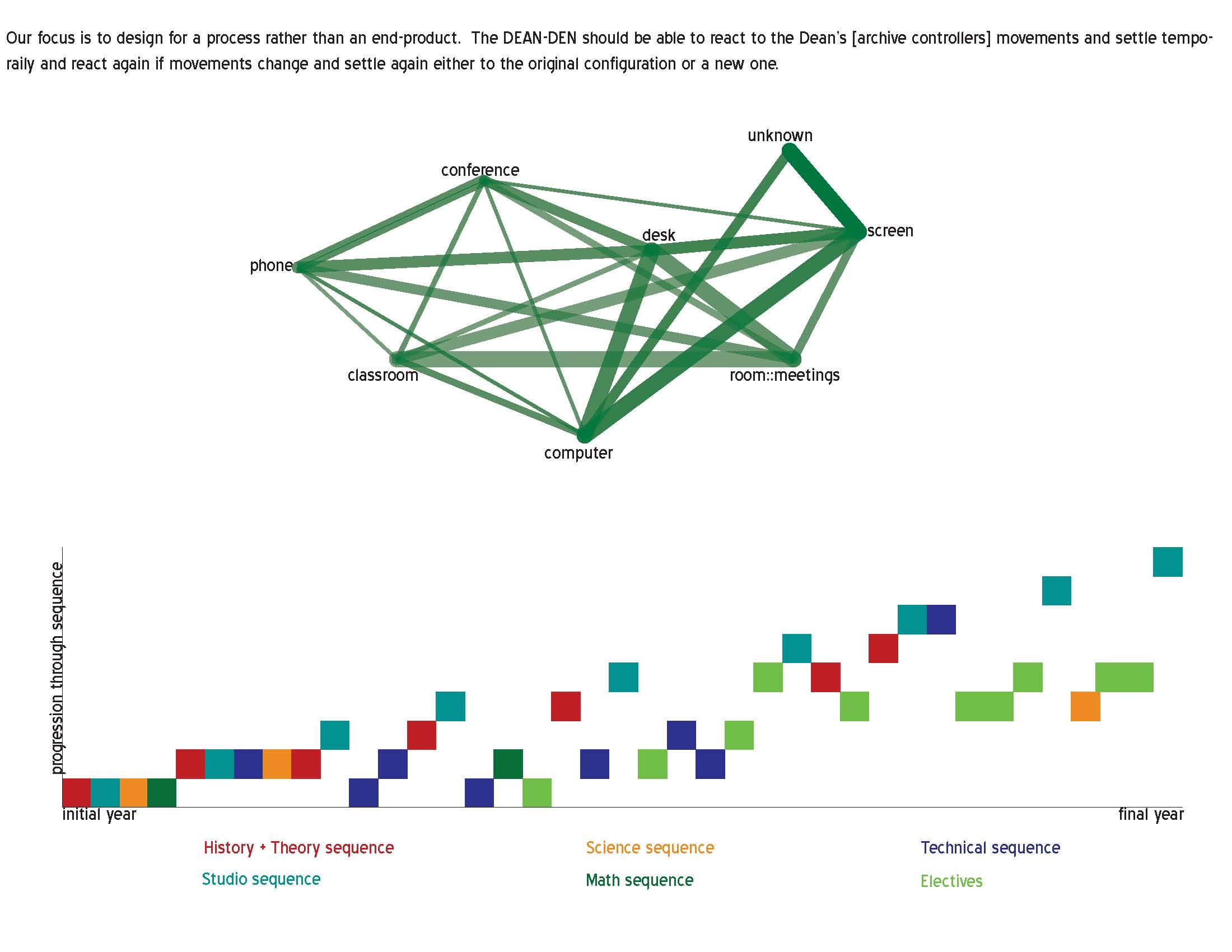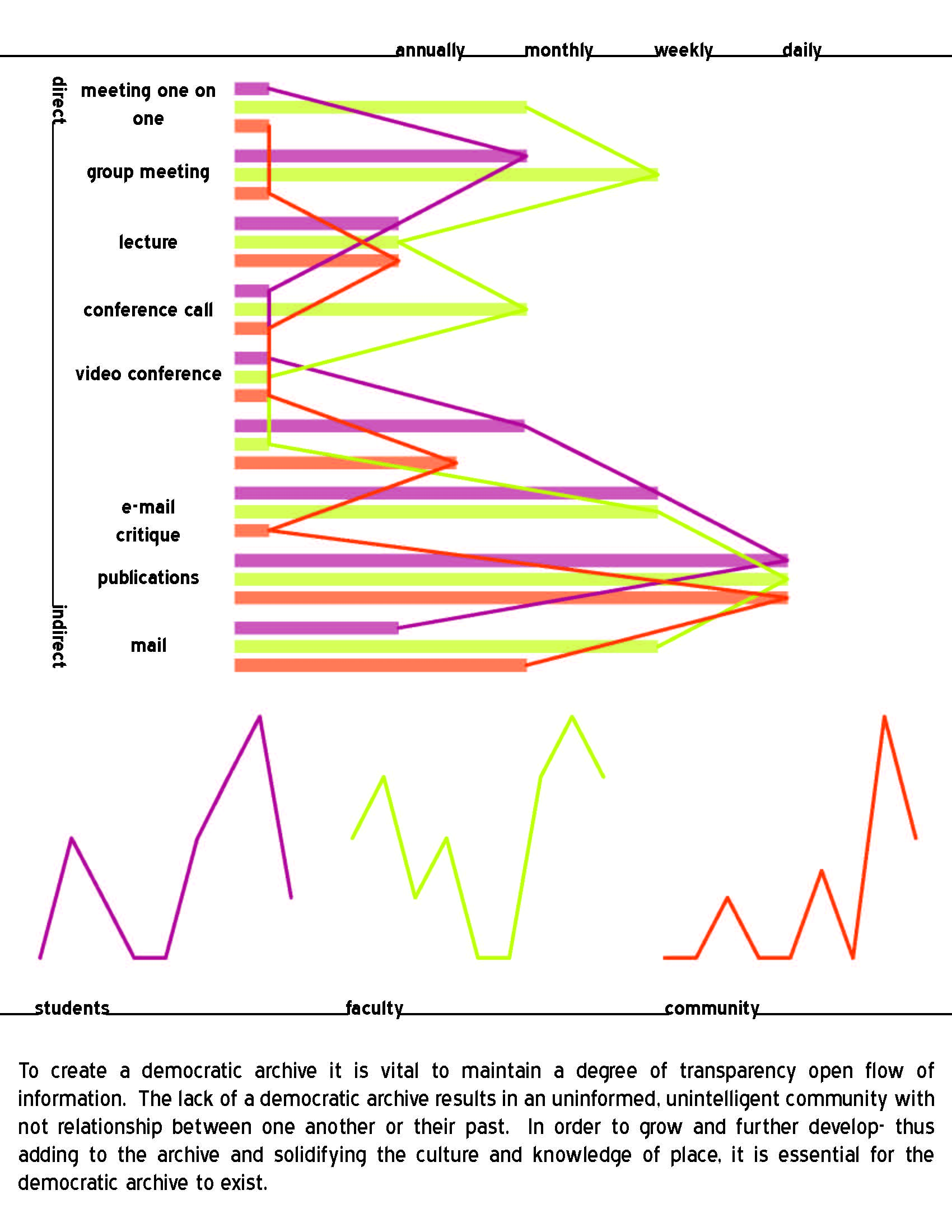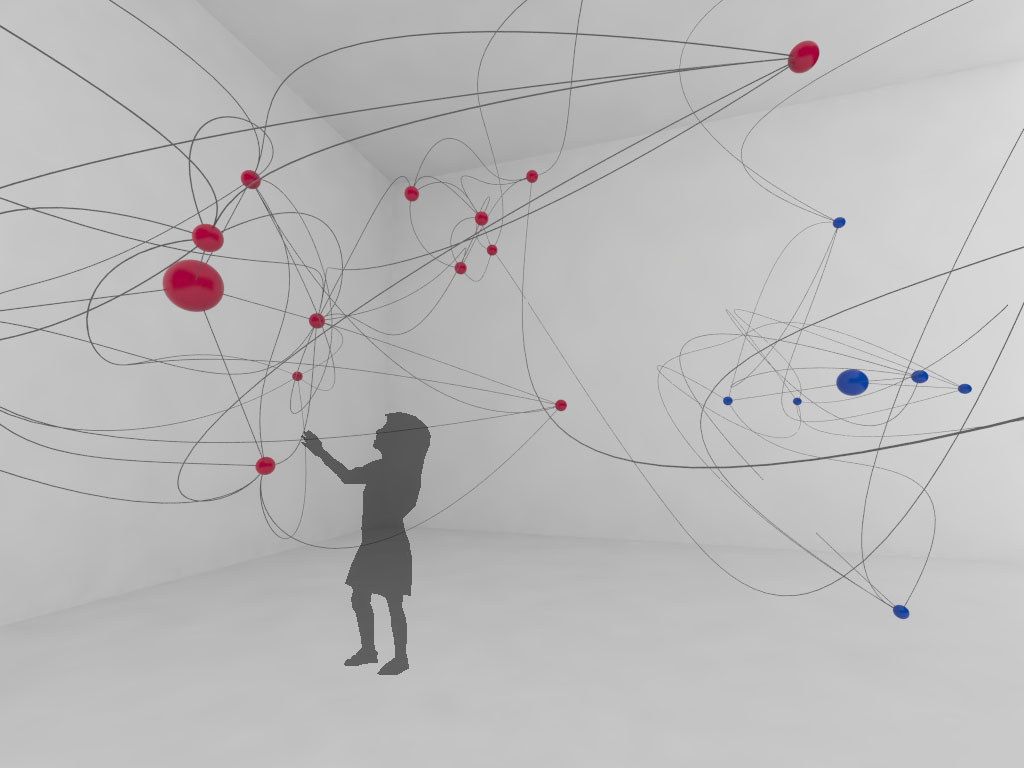zDEAN DEN REF LIB DESK
Information Space – Amy Vander Heyden & Christine Lois
Vivian Bratone and Jennifer Plume
With a critical eye toward the trends and advancements of the past twenty years, we began by projecting into the future. Aided by the writings of Katherine Hayles and Bruce Sterling, we began to image a context within which the dean’s office would be situated in the year 2029. As the effects of the digital age become more embedded in every aspect of life, information will become increasingly non-tangible.
Alongside our projections about the future of information, we analyzed the daily contacts and tasks of the dean. In analyzing the connections made by the dean throughout a typical week and typical day, it is apparent that the current time management structure is outdated and inefficient. As the school continues to expand and as there will be more demands on the future dean’s time, his daily tasks will need to be streamlined in order to let his presence be felt be each contact.
Our intervention: the Pulse Cloud Nexus [PCN]. The PCN would allow the dean’s presence to be dissolved into the fabric of the school while also returning to the academic environment some of the physicality of information.
In addition, the PCN would allow information that currently exists in a contained and stratified manner to become a resource that can self-generate and flow between environments.
The PCN structures different date types together in a single cohesive system. While providing access to information within the traditional library/archive resources, it also harvests the Pulse of the school. The Pulse encompasses several data types: student project information, research, and images; verbal communications, critiques, and lectures; experiential data, observations, and encounters; and involuntary data, internet usage, and biological stats.
The information structure of the PCN exists with adjustable filters and thresholds. Certain data types are archived and preserved, while other outdated information is discarded over time. The PCN surpasses static data structures because it intelligently restructures its information according to the inquiry.
The significance of the threshold as an important architectural moment is not lost in the year 2029. It is therefore the threshold that becomes an critical device- the Pulse Frame- to the PCN. The Pulse Frame enables the simultaneous collection and distribution of information between student and Pulse. Interacting with the Pulse Frame instantaneously harvests information to be contributed to the larger Pulse of the school and brings the user up to date with the happenings of the school.
The companion interface to the Pulse Frame is the Terminal. The Terminal enables in depth access to the Pulse Cloud Nexus. Through the Terminal students can interact with the information in the PCN. Conversely the dean can tap into the Terminal and adjust the information filters and thresholds as well as be informed about the learning happening school wide.
Mindscape Collective
a DEMOCRATIC means of EDUCATION and INFORMATION DISTRIBUTION
MINDSCAPE :: a mental or psychological scene or area of the imagination
COLLECTIVE :: denoting a number of persons or things considered as one group or whole; of, relating to, or being a group of individuals; involving all members of a group as distinct from its individuals; marked by similarity among or with the members of a group
MINDSCAPE COLLECTIVE :: an education system based on transparent streams of information; a democratic dispersion of information and critique to all members of the school of architecture
The mindscape collective calls for a two-way conversation between the faculty and students regarding all aspects of their education and social life. It encourages a more intense interaction from students allowing them equal access to all systems and networks that were previously solely presided over by the dean. The Dean’s role then becomes that of an advisor and filter to the network of communication.
Thousands of pulses within the fractal system grow in intensity throughout the semester building to the events of the midterm and final reviews. Focusing on the event of the midterm review, an increased level of communication between students and faculty will elevate the quality of the project given the resulting discussion and analysis of the proposal through the mindscapeCOLLECTIVE network. This system archives the comments for future growth of the project- the archiving process also provides extensive resources for other current and future students to access and rely on as a benchmark for their project development. The goal of the network is to be organized in a pneumonic way so that the user instinctively knows the engine’s structure and internal relationships. The network is easily able to measure and analyze activity use and the quality of the provided comments and interactions. The dean’s constant connection to students and faculty through the network allows him to be more accessible to students through “virtual rooms” within the network.
9.22 REVIEW [complete presentation diagrams]
Network Institutional Exchange
This project uses the Dean Den to establish a dialogue between the External Institutional CLOUD archive (consisting of the information and histories of institutions outside of the RPI ARCH department) and the ARCH internal archive. The goal is to create a system that increases collaboration and the spread of information throughout the RPI Architecture building and across institutions and disciplines.
The ARCH internal archive catalogues the thoughts and work of the ARCH student body. Curated by the Dean, the External archive is gathered through the connections of the dean. These connections are compiled and exhibited in periodic displays. Using the ARCH internal archive as a feedback system, the Dean can respond appropriately by observing reactions and trends of the student body, allowing him to curate and exhibit the external archive according to the needs and desires of the student body. We are looking to expand the Dean’s role as an ambassador for the School of Architecture.

- The interactive screens are used to provide feedback to the Dean. This feedback includes the value judgements of students on the Dean’s exhibitions, current trends among the student body, and the student’s current studio progress. These screens are also used by students to access the external and internal archives.
A system of screens is used to display information between students, the dean, faculty, and foreign parties. The position and display of these screens is used to generate connections between the individual work of the students and other individuals (or institutions) inside and outside the ARCH building.
Dean DEN Ref-Lib DESK intro
Context: Architecture Department at RPI
Project: DEAN-DEN/LIB-REF-DESK
Final deadline: September 22, 24
For our Thesis Section hand-shake project, students will propose a new facility for the programs of either or both the “Dean’s Office” and/or the “Librarian’s Desk”, in 2029.
Students will assume a particular set of exchanges on one or both of these programs, which would reveal itself particularly prone to a new design of the facilities, including the possibility of a new combination or relationship between them (these 2 programs).
Moreover, students will search for different tectonic configurations which would allow for the relationships to be instantiated at the different scales these programs have the potential to unfold into.
___Week 1: Programmatic research. Main programmatic exchanges “tectonic” definition.
Deliverables: analytic and synthetic diagrams
___Week 2: Material research:
Deliverables: analytic and synthetic diagrams
___Week 3: Development and presentation of final proposal
Deliverables: diagrams, final design documents including sections through the proposal, details, text and renderings that depict variations through time in the proposal.
During this exercise, Wednesdays will be dedicated to group presentations and discussions (informal pin-ups), and Fridays will be dedicated to desk critics.
For this first exercise/assignment, students will join in teams of 2 or 3. Neither the teams nor the project developed are seen as initial developments of their thesis content and logistics. After this initial assignment students will start research and work on their thesis, which might be bound or not to the material developed in the first 3 weeks. As well, teams formed for the initial exercise need not continue after the finishing deadline of the same.
Initial Suggested Readings:
DELANDA, Manuel, “Cities and Nations” in “New Philosophy for Society”
http://www.ubiroom.net/academic/DELANDAcitiesandnationsNEWPHIL.pdf
STERLING, Bruce, “Shaping Things” excerpts
http://www.umasideia.com/academic/readings05/STERLINGshapingthings.pdf
DERRIDA, Jacques, “Archive Fever”
KWINTER, Sanford, “New Babylons” in “Far From Equilibrum”
